|
PLearn 0.1
|
|
PLearn 0.1
|
Does the same thing as Hinton's deep belief nets. More...
#include <GaussianDBNClassification.h>
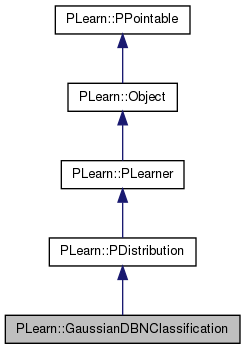
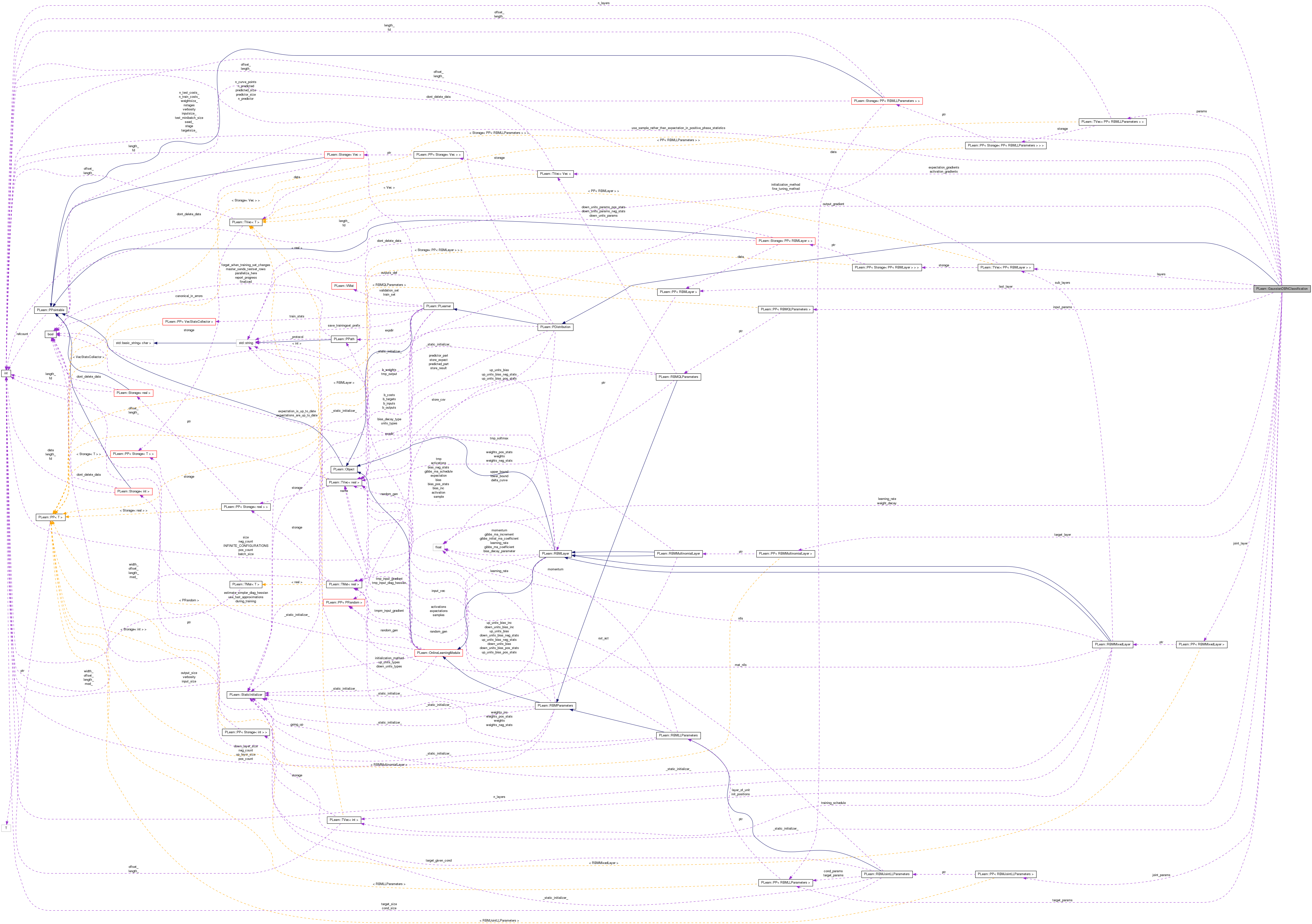
Public Member Functions | |
| GaussianDBNClassification () | |
| Default constructor. | |
| virtual real | density (const Vec &y) const |
| Return probability density p(y | x) | |
| virtual real | log_density (const Vec &y) const |
| Return log of probability density log(p(y | x)). | |
| virtual real | survival_fn (const Vec &y) const |
| Return survival function: P(Y>y | x). | |
| virtual real | cdf (const Vec &y) const |
| Return cdf: P(Y<y | x). | |
| virtual void | expectation (Vec &mu) const |
| Return E[Y | x]. | |
| virtual void | variance (Mat &cov) const |
| Return Var[Y | x]. | |
| virtual void | generate (Vec &y) const |
| Return a pseudo-random sample generated from the conditional distribution, of density p(y | x). | |
| virtual bool | setPredictorPredictedSizes (int the_predictor_size, int the_predicted_size, bool call_parent=true) |
| Generates a pseudo-random sample x from the reversed conditional distribution, of density p(x | y) (and NOT p(y | x)). | |
| virtual void | setPredictor (const Vec &predictor, bool call_parent=true) const |
| Set the value for the predictor part of a conditional probability. | |
| virtual void | forget () |
| (Re-)initializes the PDistribution in its fresh state (that state may depend on the 'seed' option). | |
| virtual void | train () |
| The role of the train method is to bring the learner up to stage == nstages, updating the train_stats collector with training costs measured on-line in the process. | |
| virtual void | computeCostsFromOutputs (const Vec &input, const Vec &output, const Vec &target, Vec &costs) const |
| Compute a cost, depending on the type of the first output : if it is the density or the log-density: NLL if it is the expectation: NLL and class error. | |
| virtual TVec< string > | getTestCostNames () const |
| Return [ "NLL" ] (the only cost computed by a PDistribution). | |
| virtual string | classname () const |
| virtual OptionList & | getOptionList () const |
| virtual OptionMap & | getOptionMap () const |
| virtual RemoteMethodMap & | getRemoteMethodMap () const |
| virtual GaussianDBNClassification * | deepCopy (CopiesMap &copies) const |
| virtual void | build () |
| Simply calls inherited::build() then build_(). | |
| virtual void | makeDeepCopyFromShallowCopy (CopiesMap &copies) |
| Transforms a shallow copy into a deep copy. | |
Static Public Member Functions | |
| static string | _classname_ () |
| static OptionList & | _getOptionList_ () |
| static RemoteMethodMap & | _getRemoteMethodMap_ () |
| static Object * | _new_instance_for_typemap_ () |
| static bool | _isa_ (const Object *o) |
| static void | _static_initialize_ () |
| static const PPath & | declaringFile () |
Public Attributes | |
| real | learning_rate |
| ### declare public option fields (such as build options) here Start your comments with Doxygen-compatible comments such as //! | |
| real | weight_decay |
| The weight decay. | |
| string | initialization_method |
| The method used to initialize the weights: | |
| int | n_layers |
| Number of layers, including input layer and last layer, but not target layer. | |
| TVec< PP< RBMLayer > > | layers |
| Layers that learn representations of the input, layers[0] is input layer, layers[n_layers-1] is last layer. | |
| PP< RBMLayer > | last_layer |
| Last layer, learning joint representations of input and target. | |
| PP< RBMMultinomialLayer > | target_layer |
| Target (or label) layer. | |
| PP< RBMMixedLayer > | joint_layer |
| Concatenation of target_layer and layers[n_layers-2]. | |
| TVec< PP< RBMLLParameters > > | params |
| RBMParameters linking the unsupervised layers. | |
| PP< RBMQLParameters > | input_params |
| PP< RBMLLParameters > | target_params |
| Parameters linking target_layer and last_layer. | |
| PP< RBMJointLLParameters > | joint_params |
| Parameters linking joint_layer and last_layer. | |
| TVec< int > | training_schedule |
| Number of examples to use during each of the different greedy steps of the training phase. | |
| string | fine_tuning_method |
| Method for fine-tuning the whole network after greedy learning. | |
| bool | use_sample_rather_than_expectation_in_positive_phase_statistics |
Static Public Attributes | |
| static StaticInitializer | _static_initializer_ |
Protected Member Functions | |
| virtual void | greedyStep (const Vec &predictor, int params_index) |
| virtual void | jointGreedyStep (const Vec &input) |
| virtual void | fineTuneByGradientDescent (const Vec &input) |
Static Protected Member Functions | |
| static void | declareOptions (OptionList &ol) |
| Declares the class options. | |
Protected Attributes | |
| TVec< Vec > | activation_gradients |
| gradients of cost wrt the activations (output of params) | |
| TVec< Vec > | expectation_gradients |
| gradients of cost wrt the expectations (output of layers) | |
| Vec | output_gradient |
| gradient wrt output activations | |
Private Types | |
| typedef PDistribution | inherited |
Private Member Functions | |
| void | build_ () |
| This does the actual building. | |
| void | build_layers () |
| Build the layers. | |
| void | build_params () |
| Build the parameters if needed. | |
Does the same thing as Hinton's deep belief nets.
Definition at line 67 of file GaussianDBNClassification.h.
typedef PDistribution PLearn::GaussianDBNClassification::inherited [private] |
Reimplemented from PLearn::PDistribution.
Definition at line 69 of file GaussianDBNClassification.h.
| PLearn::GaussianDBNClassification::GaussianDBNClassification | ( | ) |
Default constructor.
Definition at line 63 of file GaussianDBNClassification.cc.
References PLearn::PLearner::random_gen.
:
learning_rate(0.),
weight_decay(0.),
use_sample_rather_than_expectation_in_positive_phase_statistics(false)
{
random_gen = new PRandom();
}
| string PLearn::GaussianDBNClassification::_classname_ | ( | ) | [static] |
Reimplemented from PLearn::PDistribution.
Definition at line 58 of file GaussianDBNClassification.cc.
| OptionList & PLearn::GaussianDBNClassification::_getOptionList_ | ( | ) | [static] |
Reimplemented from PLearn::PDistribution.
Definition at line 58 of file GaussianDBNClassification.cc.
| RemoteMethodMap & PLearn::GaussianDBNClassification::_getRemoteMethodMap_ | ( | ) | [static] |
Reimplemented from PLearn::PDistribution.
Definition at line 58 of file GaussianDBNClassification.cc.
Reimplemented from PLearn::PDistribution.
Definition at line 58 of file GaussianDBNClassification.cc.
| Object * PLearn::GaussianDBNClassification::_new_instance_for_typemap_ | ( | ) | [static] |
Reimplemented from PLearn::PDistribution.
Definition at line 58 of file GaussianDBNClassification.cc.
| StaticInitializer GaussianDBNClassification::_static_initializer_ & PLearn::GaussianDBNClassification::_static_initialize_ | ( | ) | [static] |
Reimplemented from PLearn::PDistribution.
Definition at line 58 of file GaussianDBNClassification.cc.
| void PLearn::GaussianDBNClassification::build | ( | ) | [virtual] |
Simply calls inherited::build() then build_().
Reimplemented from PLearn::PDistribution.
Definition at line 168 of file GaussianDBNClassification.cc.
References PLearn::PDistribution::build(), and build_().
{
// ### Nothing to add here, simply calls build_().
inherited::build();
build_();
}
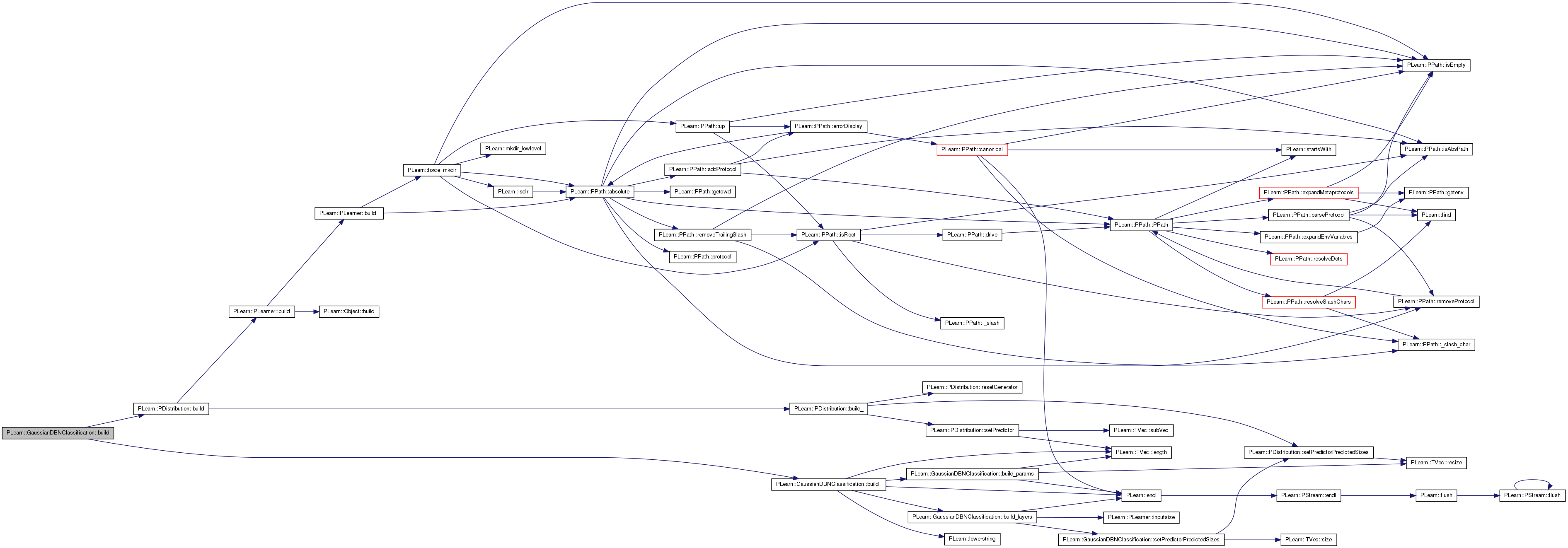
| void PLearn::GaussianDBNClassification::build_ | ( | ) | [private] |
This does the actual building.
Reimplemented from PLearn::PDistribution.
Definition at line 178 of file GaussianDBNClassification.cc.
References build_layers(), build_params(), PLearn::endl(), fine_tuning_method, initialization_method, layers, PLearn::TVec< T >::length(), PLearn::lowerstring(), n_layers, PLERROR, and training_schedule.
Referenced by build().
{
MODULE_LOG << "build_() called" << endl;
n_layers = layers.length();
if( n_layers <= 1 )
return;
// check value of initialization_method
string im = lowerstring( initialization_method );
if( im == "" || im == "uniform_sqrt" )
initialization_method = "uniform_sqrt";
else if( im == "uniform_linear" )
initialization_method = im;
else if( im == "zero" )
initialization_method = im;
else
PLERROR( "RBMParameters::build_ - initialization_method\n"
"\"%s\" unknown.\n", initialization_method.c_str() );
MODULE_LOG << " initialization_method = \"" << initialization_method
<< "\"" << endl;
// check value of fine_tuning_method
string ftm = lowerstring( fine_tuning_method );
if( ftm == "" | ftm == "none" )
fine_tuning_method = "";
else if( ftm == "cd" | ftm == "contrastive_divergence" )
fine_tuning_method = "CD";
else if( ftm == "egd" | ftm == "error_gradient_descent" )
fine_tuning_method = "EGD";
else if( ftm == "ws" | ftm == "wake_sleep" )
fine_tuning_method = "WS";
else
PLERROR( "GaussianDBNClassification::build_ - fine_tuning_method \"%s\"\n"
"is unknown.\n", fine_tuning_method.c_str() );
MODULE_LOG << " fine_tuning_method = \"" << fine_tuning_method << "\""
<< endl;
//TODO: build structure to store gradients during gradient descent
if( training_schedule.length() != n_layers )
training_schedule = TVec<int>( n_layers, 1000000 );
MODULE_LOG << " training_schedule = " << training_schedule << endl;
MODULE_LOG << endl;
build_layers();
build_params();
}


| void PLearn::GaussianDBNClassification::build_layers | ( | ) | [private] |
Build the layers.
Definition at line 225 of file GaussianDBNClassification.cc.
References PLearn::endl(), i, PLearn::PLearner::inputsize(), PLearn::PLearner::inputsize_, joint_layer, last_layer, layers, n_layers, PLearn::PDistribution::n_predicted, PLearn::PDistribution::n_predictor, PLASSERT, PLearn::PLearner::random_gen, setPredictorPredictedSizes(), and target_layer.
Referenced by build_().
{
MODULE_LOG << "build_layers() called" << endl;
if( inputsize_ >= 0 )
{
PLASSERT( layers[0]->size + target_layer->size == inputsize() );
setPredictorPredictedSizes( layers[0]->size,
target_layer->size, false );
MODULE_LOG << " n_predictor = " << n_predictor << endl;
MODULE_LOG << " n_predicted = " << n_predicted << endl;
}
for( int i=0 ; i<n_layers ; i++ )
layers[i]->random_gen = random_gen;
target_layer->random_gen = random_gen;
last_layer = layers[n_layers-1];
// concatenate target_layer and layers[n_layers-2] into joint_layer
TVec< PP<RBMLayer> > the_sub_layers( 2 );
the_sub_layers[0] = target_layer;
the_sub_layers[1] = layers[n_layers-2];
joint_layer = new RBMMixedLayer( the_sub_layers );
joint_layer->random_gen = random_gen;
}


| void PLearn::GaussianDBNClassification::build_params | ( | ) | [private] |
Build the parameters if needed.
Definition at line 251 of file GaussianDBNClassification.cc.
References activation_gradients, PLearn::endl(), expectation_gradients, i, initialization_method, input_params, joint_params, last_layer, layers, learning_rate, PLearn::TVec< T >::length(), n_layers, PLearn::PDistribution::n_predicted, output_gradient, params, PLERROR, PLearn::PLearner::random_gen, PLearn::TVec< T >::resize(), target_layer, and target_params.
Referenced by build_().
{
MODULE_LOG << "build_params() called" << endl;
if( params.length() == 0 )
{
input_params = new RBMQLParameters() ;
params.resize( n_layers-1 );
for( int i=1 ; i<n_layers-1 ; i++ )
params[i] = new RBMLLParameters();
// params[0] is not being using, it is not being created
}
else if( params.length() != n_layers-1 )
PLERROR( "GaussianDBNClassification::build_params - params.length() should\n"
"be equal to layers.length()-1 (%d != %d).\n",
params.length(), n_layers-1 );
activation_gradients.resize( n_layers-1 );
expectation_gradients.resize( n_layers-1 );
output_gradient.resize( n_predicted );
input_params->down_units_types = layers[0]->units_types;
input_params->up_units_types = layers[1]->units_types;
input_params->learning_rate = learning_rate;
input_params->initialization_method = initialization_method;
input_params->random_gen = random_gen;
input_params->build();
activation_gradients[0].resize( input_params->down_layer_size );
expectation_gradients[0].resize( input_params->down_layer_size );
for( int i=1 ; i<n_layers-1 ; i++ )
{
//TODO: call changeOptions instead
params[i]->down_units_types = layers[i]->units_types;
params[i]->up_units_types = layers[i+1]->units_types;
params[i]->learning_rate = learning_rate;
params[i]->initialization_method = initialization_method;
params[i]->random_gen = random_gen;
params[i]->build();
activation_gradients[i].resize( params[i]->down_layer_size );
expectation_gradients[i].resize( params[i]->down_layer_size );
}
if( target_layer && !target_params )
target_params = new RBMLLParameters();
//TODO: call changeOptions instead
target_params->down_units_types = target_layer->units_types;
target_params->up_units_types = last_layer->units_types;
target_params->learning_rate = learning_rate;
target_params->initialization_method = initialization_method;
target_params->random_gen = random_gen;
target_params->build();
// build joint_params from params[n_layers-1] and target_params
joint_params = new RBMJointLLParameters( target_params,
params[n_layers-2] );
joint_params->learning_rate = learning_rate;
joint_params->random_gen = random_gen;
}


Return cdf: P(Y<y | x).
Reimplemented from PLearn::PDistribution.
Definition at line 352 of file GaussianDBNClassification.cc.
References PLERROR.
{
PLERROR("cdf not implemented for GaussianDBNClassification"); return 0;
}
| string PLearn::GaussianDBNClassification::classname | ( | ) | const [virtual] |
Reimplemented from PLearn::PDistribution.
Definition at line 58 of file GaussianDBNClassification.cc.
Referenced by train().

| void PLearn::GaussianDBNClassification::computeCostsFromOutputs | ( | const Vec & | input, |
| const Vec & | output, | ||
| const Vec & | target, | ||
| Vec & | costs | ||
| ) | const [virtual] |
Compute a cost, depending on the type of the first output : if it is the density or the log-density: NLL if it is the expectation: NLL and class error.
Reimplemented from PLearn::PDistribution.
Definition at line 827 of file GaussianDBNClassification.cc.
References PLearn::argmax(), c, PLearn::PDistribution::computeCostsFromOutputs(), i, PLearn::is_equal(), PLearn::PDistribution::n_predicted, PLearn::PDistribution::outputs_def, pl_log, PLASSERT, PLearn::PDistribution::predicted_part, PLearn::TVec< T >::resize(), and PLearn::PDistribution::splitCond().
{
char c = outputs_def[0];
if( c == 'l' || c == 'd' )
inherited::computeCostsFromOutputs(input, output, target, costs);
else if( c == 'e' )
{
costs.resize( 2 );
splitCond(input);
// actual_index is the actual 'target'
int actual_index = argmax(predicted_part);
#ifdef BOUNDCHECK
for( int i=0 ; i<n_predicted ; i++ )
PLASSERT( is_equal( predicted_part[i], 0. ) ||
i == actual_index && is_equal( predicted_part[i], 1. ) );
#endif
costs[0] = -pl_log( output[actual_index] );
// predicted_index is the most probable predicted class
int predicted_index = argmax(output);
if( predicted_index == actual_index )
costs[1] = 0;
else
costs[1] = 1;
}
}

| void PLearn::GaussianDBNClassification::declareOptions | ( | OptionList & | ol | ) | [static, protected] |
Declares the class options.
Reimplemented from PLearn::PDistribution.
Definition at line 74 of file GaussianDBNClassification.cc.
References PLearn::OptionBase::buildoption, PLearn::declareOption(), PLearn::PDistribution::declareOptions(), fine_tuning_method, initialization_method, input_params, joint_layer, joint_params, last_layer, layers, learning_rate, PLearn::OptionBase::learntoption, n_layers, params, target_layer, target_params, training_schedule, use_sample_rather_than_expectation_in_positive_phase_statistics, and weight_decay.
{
declareOption(ol, "learning_rate", &GaussianDBNClassification::learning_rate,
OptionBase::buildoption,
"Learning rate");
declareOption(ol, "weight_decay", &GaussianDBNClassification::weight_decay,
OptionBase::buildoption,
"Weight decay");
declareOption(ol, "initialization_method",
&GaussianDBNClassification::initialization_method,
OptionBase::buildoption,
"The method used to initialize the weights:\n"
" - \"uniform_linear\" = a uniform law in [-1/d, 1/d]\n"
" - \"uniform_sqrt\" = a uniform law in [-1/sqrt(d),"
" 1/sqrt(d)]\n"
" - \"zero\" = all weights are set to 0,\n"
"where d = max( up_layer_size, down_layer_size ).\n");
declareOption(ol, "training_schedule",
&GaussianDBNClassification::training_schedule,
OptionBase::buildoption,
"Number of examples to use during each of the different"
" greedy\n"
"steps of the training phase.\n");
declareOption(ol, "fine_tuning_method",
&GaussianDBNClassification::fine_tuning_method,
OptionBase::buildoption,
"Method for fine-tuning the whole network after greedy"
" learning.\n"
"One of:\n"
" - \"none\"\n"
" - \"CD\" or \"contrastive_divergence\"\n"
" - \"EGD\" or \"error_gradient_descent\"\n"
" - \"WS\" or \"wake_sleep\".\n");
declareOption(ol, "layers", &GaussianDBNClassification::layers,
OptionBase::buildoption,
"Layers that learn representations of the input,"
" unsupervisedly.\n"
"layers[0] is input layer.\n");
declareOption(ol, "target_layer", &GaussianDBNClassification::target_layer,
OptionBase::buildoption,
"Target (or label) layer");
declareOption(ol, "params", &GaussianDBNClassification::params,
OptionBase::buildoption,
"RBMParameters linking the unsupervised layers.\n"
"params[i] links layers[i] and layers[i+1], except for"
"params[n_layers-1],\n"
"that links layers[n_layers-1] and last_layer.\n");
declareOption(ol, "target_params", &GaussianDBNClassification::target_params,
OptionBase::buildoption,
"Parameters linking target_layer and last_layer");
declareOption(ol, "input_params", &GaussianDBNClassification::input_params,
OptionBase::buildoption,
"Parameters linking layer[0] and layer[1]");
declareOption(ol, "use_sample_rather_than_expectation_in_positive_phase_statistics",
&GaussianDBNClassification::use_sample_rather_than_expectation_in_positive_phase_statistics,
OptionBase::buildoption,
"In positive phase statistics use output->sample * input\n"
"rather than output->expectation * input.\n");
declareOption(ol, "n_layers", &GaussianDBNClassification::n_layers,
OptionBase::learntoption,
"Number of unsupervised layers, including input layer");
declareOption(ol, "last_layer", &GaussianDBNClassification::last_layer,
OptionBase::learntoption,
"Last layer, learning joint representations of input and"
" target");
declareOption(ol, "joint_layer", &GaussianDBNClassification::joint_layer,
OptionBase::learntoption,
"Concatenation of target_layer and layers[n_layers-1]");
declareOption(ol, "joint_params", &GaussianDBNClassification::joint_params,
OptionBase::learntoption,
"Parameters linking joint_layer and last_layer");
// Now call the parent class' declareOptions().
inherited::declareOptions(ol);
}

| static const PPath& PLearn::GaussianDBNClassification::declaringFile | ( | ) | [inline, static] |
Reimplemented from PLearn::PDistribution.
Definition at line 245 of file GaussianDBNClassification.h.
:
//##### Protected Options ###############################################
| GaussianDBNClassification * PLearn::GaussianDBNClassification::deepCopy | ( | CopiesMap & | copies | ) | const [virtual] |
Reimplemented from PLearn::PDistribution.
Definition at line 58 of file GaussianDBNClassification.cc.
Return probability density p(y | x)
Reimplemented from PLearn::PDistribution.
Definition at line 391 of file GaussianDBNClassification.cc.
References PLearn::argmax(), expectation(), i, PLearn::is_equal(), PLearn::PDistribution::n_predicted, PLASSERT, PLearn::TVec< T >::size(), and PLearn::PDistribution::store_expect.
Referenced by log_density().
{
PLASSERT( y.size() == n_predicted );
// TODO: 'y'[0] devrait plutot etre l'entier "index" lui-meme!
int index = argmax( y );
// If y != onehot( index ), then density is 0
if( !is_equal( y[index], 1. ) )
return 0;
for( int i=0 ; i<n_predicted ; i++ )
if( !is_equal( y[i], 0 ) && i != index )
return 0;
expectation( store_expect );
return store_expect[index];
}


| void PLearn::GaussianDBNClassification::expectation | ( | Vec & | mu | ) | const [virtual] |
Return E[Y | x].
Reimplemented from PLearn::PDistribution.
Definition at line 360 of file GaussianDBNClassification.cc.
References i, input_params, joint_params, layers, n_layers, params, PLearn::PDistribution::predicted_size, PLearn::PDistribution::predictor_part, PLearn::TVec< T >::resize(), and target_layer.
Referenced by density(), fineTuneByGradientDescent(), greedyStep(), and jointGreedyStep().
{
mu.resize( predicted_size );
// Propagate input (predictor_part) until penultimate layer
layers[0]->expectation << predictor_part;
input_params->setAsDownInput(layers[0]->expectation) ;
layers[1]->getAllActivations( (RBMQLParameters*) input_params );
layers[1]->computeExpectation();
for( int i=1 ; i<n_layers-2 ; i++ )
{
params[i]->setAsDownInput( layers[i]->expectation );
layers[i+1]->getAllActivations( (RBMLLParameters*) params[i] );
layers[i+1]->computeExpectation();
}
// Set layers[n_layers-2]->expectation (penultimate) as conditionning input
// of joint_params
joint_params->setAsCondInput( layers[n_layers-2]->expectation );
// Get all activations on target_layer from target_params
target_layer->getAllActivations( (RBMLLParameters*) joint_params );
target_layer->computeExpectation();
mu << target_layer->expectation;
}


| void PLearn::GaussianDBNClassification::fineTuneByGradientDescent | ( | const Vec & | input | ) | [protected, virtual] |
Definition at line 797 of file GaussianDBNClassification.cc.
References activation_gradients, PLearn::argmax(), expectation(), expectation_gradients, i, joint_params, layers, n_layers, output_gradient, params, PLearn::PDistribution::predicted_part, PLearn::PDistribution::splitCond(), and target_layer.
Referenced by train().
{
// split input in predictor_part and predicted_part
splitCond(input);
// compute predicted_part expectation, conditioned on predictor_part
// (forward pass)
expectation( output_gradient );
int actual_index = argmax(predicted_part);
output_gradient[actual_index] -= 1.;
joint_params->bpropUpdate( layers[n_layers-2]->expectation,
target_layer->expectation,
expectation_gradients[n_layers-2],
output_gradient );
for( int i=n_layers-2 ; i>0 ; i-- )
{
layers[i]->bpropUpdate( layers[i]->activations,
layers[i]->expectation,
activation_gradients[i],
expectation_gradients[i] );
params[i-1]->bpropUpdate( layers[i-1]->expectation,
layers[i]->activations,
expectation_gradients[i-1],
activation_gradients[i] );
}
}


| void PLearn::GaussianDBNClassification::forget | ( | ) | [virtual] |
(Re-)initializes the PDistribution in its fresh state (that state may depend on the 'seed' option).
And sets 'stage' back to 0 (this is the stage of a fresh learner!). ### You may remove this method if your distribution does not ### implement it.
A typical forget() method should do the following:
Reimplemented from PLearn::PDistribution.
Definition at line 318 of file GaussianDBNClassification.cc.
References PLearn::endl(), i, input_params, layers, n_layers, params, PLearn::PDistribution::resetGenerator(), PLearn::PLearner::seed_, PLearn::PLearner::stage, target_layer, and target_params.
{
MODULE_LOG << "forget() called" << endl;
resetGenerator(seed_);
input_params->forget() ;
for( int i=1 ; i<n_layers-1 ; i++ )
params[i]->forget();
for( int i=0 ; i<n_layers ; i++ )
layers[i]->reset();
target_params->forget();
target_layer->reset();
stage = 0;
}

| void PLearn::GaussianDBNClassification::generate | ( | Vec & | y | ) | const [virtual] |
Return a pseudo-random sample generated from the conditional distribution, of density p(y | x).
Reimplemented from PLearn::PDistribution.
Definition at line 344 of file GaussianDBNClassification.cc.
References PLERROR.
{
PLERROR("generate not implemented for GaussianDBNClassification");
}
| OptionList & PLearn::GaussianDBNClassification::getOptionList | ( | ) | const [virtual] |
Reimplemented from PLearn::PDistribution.
Definition at line 58 of file GaussianDBNClassification.cc.
| OptionMap & PLearn::GaussianDBNClassification::getOptionMap | ( | ) | const [virtual] |
Reimplemented from PLearn::PDistribution.
Definition at line 58 of file GaussianDBNClassification.cc.
| RemoteMethodMap & PLearn::GaussianDBNClassification::getRemoteMethodMap | ( | ) | const [virtual] |
Reimplemented from PLearn::PDistribution.
Definition at line 58 of file GaussianDBNClassification.cc.
| TVec< string > PLearn::GaussianDBNClassification::getTestCostNames | ( | ) | const [virtual] |
Return [ "NLL" ] (the only cost computed by a PDistribution).
Reimplemented from PLearn::PDistribution.
Definition at line 858 of file GaussianDBNClassification.cc.
References PLearn::TVec< T >::append(), c, and PLearn::PDistribution::outputs_def.
{
char c = outputs_def[0];
TVec<string> result;
if( c == 'l' || c == 'd' )
result.append( "NLL" );
else if( c == 'e' )
{
result.append( "NLL" );
result.append( "class_error" );
}
return result;
}

| void PLearn::GaussianDBNClassification::greedyStep | ( | const Vec & | predictor, |
| int | params_index | ||
| ) | [protected, virtual] |
Definition at line 672 of file GaussianDBNClassification.cc.
References PLearn::RBMQLParameters::accumulateNegStats(), PLearn::RBMQLParameters::accumulatePosStats(), expectation(), i, input_params, layers, params, PLearn::sample(), PLearn::RBMParameters::setAsDownInput(), PLearn::RBMParameters::setAsUpInput(), PLearn::RBMQLParameters::update(), and use_sample_rather_than_expectation_in_positive_phase_statistics.
Referenced by train().
{
// deterministic propagation until we reach index
layers[0]->expectation << predictor;
input_params->setAsDownInput( layers[0]->expectation );
layers[1]->getAllActivations( (RBMQLParameters*) input_params );
layers[1]->computeExpectation();
for( int i=1 ; i<index ; i++ )
{
params[i]->setAsDownInput( layers[i]->expectation );
layers[i+1]->getAllActivations( (RBMLLParameters*) params[i] );
layers[i+1]->computeExpectation();
}
// positive phase
if (index == 0) {
input_params->setAsDownInput( layers[index]->expectation );
layers[index+1]->getAllActivations((RBMQLParameters*) input_params);
layers[index+1]->computeExpectation();
layers[index+1]->generateSample();
if (use_sample_rather_than_expectation_in_positive_phase_statistics)
input_params->accumulatePosStats(layers[index]->expectation,
layers[index+1]->sample );
else
input_params->accumulatePosStats(layers[index]->expectation,
layers[index+1]->expectation );
// down propagation
input_params->setAsUpInput( layers[index+1]->sample );
layers[index]->getAllActivations( (RBMQLParameters*) input_params );
// negative phase
layers[index]->generateSample();
input_params->setAsDownInput( layers[index]->sample );
layers[index+1]->getAllActivations((RBMQLParameters*) input_params);
layers[index+1]->computeExpectation();
input_params->accumulateNegStats( layers[index]->sample,
layers[index+1]->expectation );
// update
input_params->update();
}
else {
params[index]->setAsDownInput( layers[index]->expectation );
layers[index+1]->getAllActivations((RBMLLParameters*) params[index]);
layers[index+1]->computeExpectation();
layers[index+1]->generateSample();
if (use_sample_rather_than_expectation_in_positive_phase_statistics)
params[index]->accumulatePosStats(layers[index]->expectation,
layers[index+1]->sample );
else
params[index]->accumulatePosStats(layers[index]->expectation,
layers[index+1]->expectation );
// down propagation
params[index]->setAsUpInput( layers[index+1]->sample );
layers[index]->getAllActivations( (RBMLLParameters*) params[index] );
// negative phase
layers[index]->generateSample();
params[index]->setAsDownInput( layers[index]->sample );
layers[index+1]->getAllActivations((RBMLLParameters*) params[index]);
layers[index+1]->computeExpectation();
params[index]->accumulateNegStats( layers[index]->sample,
layers[index+1]->expectation );
// update
params[index]->update();
}
}
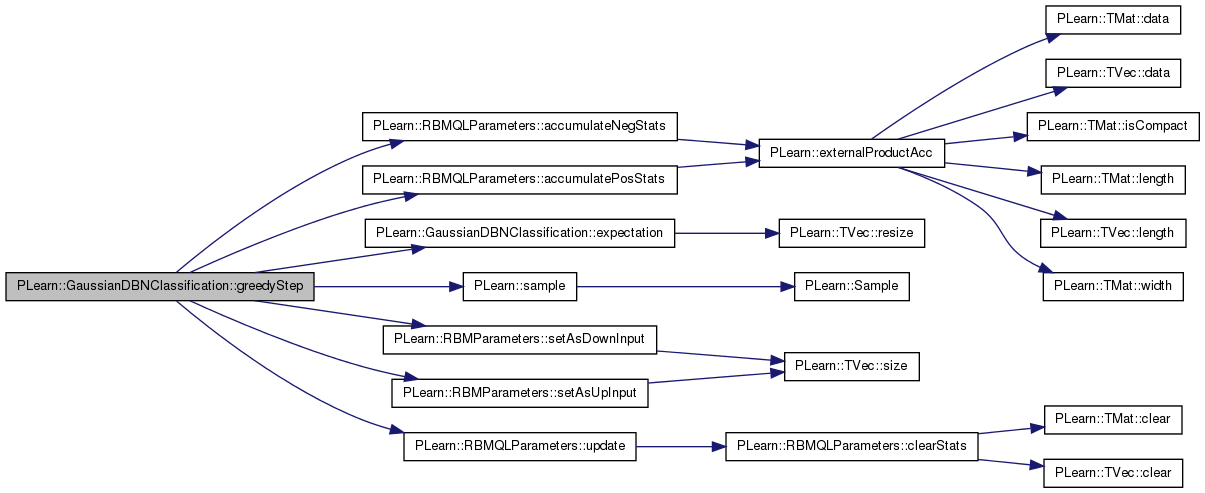

| void PLearn::GaussianDBNClassification::jointGreedyStep | ( | const Vec & | input | ) | [protected, virtual] |
Definition at line 749 of file GaussianDBNClassification.cc.
References PLearn::RBMLLParameters::accumulateNegStats(), PLearn::RBMLLParameters::accumulatePosStats(), expectation(), i, input_params, joint_layer, joint_params, last_layer, layers, n_layers, PLearn::PDistribution::n_predicted, PLearn::PDistribution::n_predictor, params, PLearn::RBMParameters::setAsDownInput(), PLearn::RBMParameters::setAsUpInput(), PLearn::TVec< T >::subVec(), target_layer, PLearn::RBMLLParameters::update(), and use_sample_rather_than_expectation_in_positive_phase_statistics.
Referenced by train().
{
// deterministic propagation until we reach n_layers-2, setting the input
// of the "input" part of joint_layer
layers[0]->expectation << input.subVec( 0, n_predictor );
input_params->setAsDownInput( layers[0]->expectation );
layers[1]->getAllActivations( (RBMQLParameters*) input_params );
layers[1]->computeExpectation();
for( int i=1 ; i<n_layers-2 ; i++ )
{
params[i]->setAsDownInput( layers[i]->expectation );
layers[i+1]->getAllActivations( (RBMLLParameters*) params[i] );
layers[i+1]->computeExpectation();
}
// now fill the "target" part of joint_layer
target_layer->expectation << input.subVec( n_predictor, n_predicted );
// positive phase
joint_params->setAsDownInput( joint_layer->expectation );
last_layer->getAllActivations( (RBMLLParameters*) joint_params );
last_layer->computeExpectation();
last_layer->generateSample();
if (use_sample_rather_than_expectation_in_positive_phase_statistics)
joint_params->accumulatePosStats( joint_layer->expectation,
last_layer->sample );
else
joint_params->accumulatePosStats( joint_layer->expectation,
last_layer->expectation );
// down propagation
joint_params->setAsUpInput( last_layer->sample );
joint_layer->getAllActivations( (RBMLLParameters*) joint_params );
// negative phase
joint_layer->generateSample();
joint_params->setAsDownInput( joint_layer->sample );
last_layer->getAllActivations( (RBMLLParameters*) joint_params );
last_layer->computeExpectation();
joint_params->accumulateNegStats( joint_layer->sample,
last_layer->expectation );
// update
joint_params->update();
}
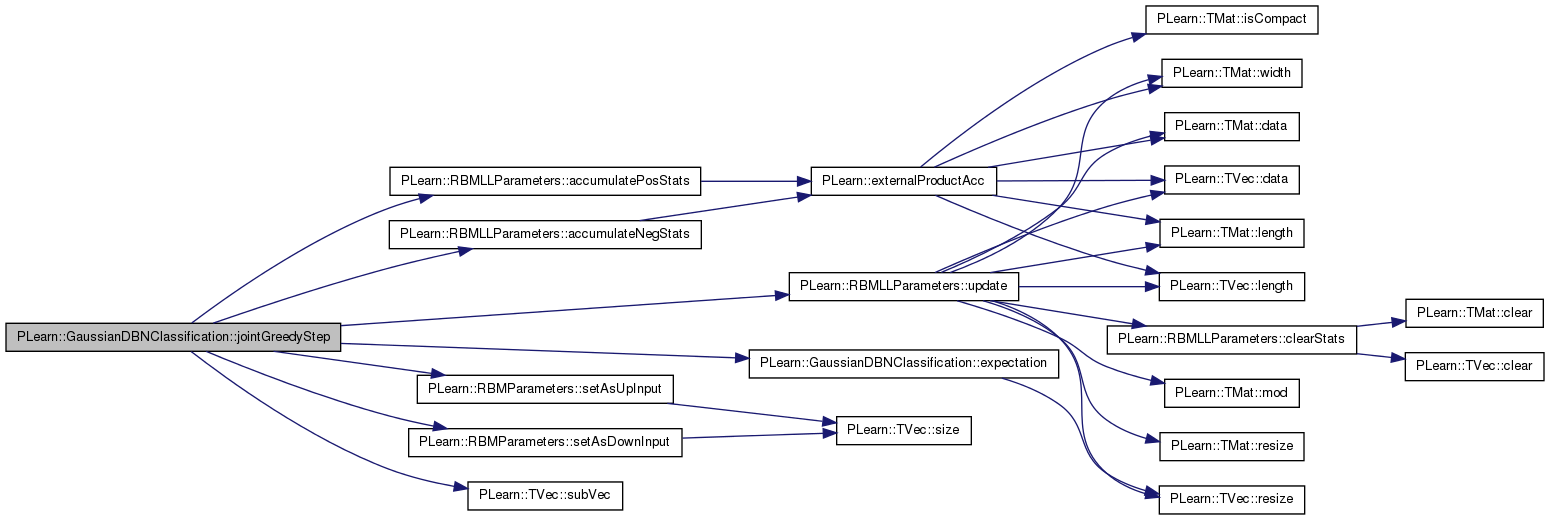

Return log of probability density log(p(y | x)).
Reimplemented from PLearn::PDistribution.
Definition at line 413 of file GaussianDBNClassification.cc.
References density(), and pl_log.

| void PLearn::GaussianDBNClassification::makeDeepCopyFromShallowCopy | ( | CopiesMap & | copies | ) | [virtual] |
Transforms a shallow copy into a deep copy.
Reimplemented from PLearn::PDistribution.
Definition at line 437 of file GaussianDBNClassification.cc.
References PLearn::deepCopyField(), input_params, joint_layer, joint_params, last_layer, layers, PLearn::PDistribution::makeDeepCopyFromShallowCopy(), params, target_layer, target_params, and training_schedule.
{
inherited::makeDeepCopyFromShallowCopy(copies);
deepCopyField(layers, copies);
deepCopyField(last_layer, copies);
deepCopyField(target_layer, copies);
deepCopyField(joint_layer, copies);
deepCopyField(params, copies);
deepCopyField(joint_params, copies);
deepCopyField(input_params, copies);
deepCopyField(target_params, copies);
deepCopyField(training_schedule, copies);
}

| void PLearn::GaussianDBNClassification::setPredictor | ( | const Vec & | predictor, |
| bool | call_parent = true |
||
| ) | const [virtual] |
Set the value for the predictor part of a conditional probability.
Reimplemented from PLearn::PDistribution.
Definition at line 455 of file GaussianDBNClassification.cc.
References PLearn::PDistribution::setPredictor().
{
if (call_parent)
inherited::setPredictor(predictor, true);
// ### Add here any specific code required by your subclass.
}

| bool PLearn::GaussianDBNClassification::setPredictorPredictedSizes | ( | int | the_predictor_size, |
| int | the_predicted_size, | ||
| bool | call_parent = true |
||
| ) | [virtual] |
Generates a pseudo-random sample x from the reversed conditional distribution, of density p(x | y) (and NOT p(y | x)).
i.e., generates a "predictor" part given a "predicted" part, regardless of any previously set predictor. Set the 'predictor' and 'predicted' sizes for this distribution.
Reimplemented from PLearn::PDistribution.
Definition at line 466 of file GaussianDBNClassification.cc.
References layers, PLearn::PDistribution::n_predicted, PLearn::PDistribution::n_predictor, PLERROR, PLearn::PDistribution::setPredictorPredictedSizes(), PLearn::TVec< T >::size(), and target_layer.
Referenced by build_layers().
{
bool sizes_have_changed = false;
if (call_parent)
sizes_have_changed = inherited::setPredictorPredictedSizes(
the_predictor_size, the_predicted_size, true);
// ### Add here any specific code required by your subclass.
if( the_predictor_size >= 0 && the_predictor_size != layers[0]->size ||
the_predicted_size >= 0 && the_predicted_size != target_layer->size )
PLERROR( "GaussianDBNClassification::setPredictorPredictedSizes - \n"
"n_predictor should be equal to layer[0]->size (%d)\n"
"n_predicted should be equal to target_layer->size (%d).\n",
layers[0]->size, target_layer->size );
n_predictor = layers[0]->size;
n_predicted = target_layer->size;
// Returned value.
return sizes_have_changed;
}


Return survival function: P(Y>y | x).
Reimplemented from PLearn::PDistribution.
Definition at line 421 of file GaussianDBNClassification.cc.
References PLERROR.
{
PLERROR("survival_fn not implemented for GaussianDBNClassification"); return 0;
}
| void PLearn::GaussianDBNClassification::train | ( | ) | [virtual] |
The role of the train method is to bring the learner up to stage == nstages, updating the train_stats collector with training costs measured on-line in the process.
Reimplemented from PLearn::PDistribution.
Definition at line 494 of file GaussianDBNClassification.cc.
References classname(), PLearn::endl(), fine_tuning_method, fineTuneByGradientDescent(), PLearn::VMat::getExample(), greedyStep(), i, PLearn::PLearner::initTrain(), PLearn::PLearner::inputsize(), jointGreedyStep(), PLearn::VMat::length(), n_layers, PLearn::PDistribution::n_predictor, PLearn::PLearner::nstages, PLERROR, PLearn::PLearner::report_progress, PLearn::sample(), PLearn::PLearner::stage, PLearn::TVec< T >::subVec(), PLearn::PLearner::targetsize(), PLearn::tostring(), PLearn::PLearner::train_set, PLearn::PLearner::train_stats, training_schedule, and PLearn::ProgressBar::update().
{
MODULE_LOG << "train() called" << endl;
// The role of the train method is to bring the learner up to
// stage==nstages, updating train_stats with training costs measured
// on-line in the process.
/* TYPICAL CODE:
static Vec input; // static so we don't reallocate memory each time...
static Vec target; // (but be careful that static means shared!)
input.resize(inputsize()); // the train_set's inputsize()
target.resize(targetsize()); // the train_set's targetsize()
real weight;
// This generic PLearner method does a number of standard stuff useful for
// (almost) any learner, and return 'false' if no training should take
// place. See PLearner.h for more details.
if (!initTrain())
return;
while(stage<nstages)
{
// clear statistics of previous epoch
train_stats->forget();
//... train for 1 stage, and update train_stats,
// using train_set->getExample(input, target, weight)
// and train_stats->update(train_costs)
++stage;
train_stats->finalize(); // finalize statistics for this epoch
}
*/
Vec input( inputsize() );
Vec target( targetsize() ); // unused
real weight; // unused
if( !initTrain() )
{
MODULE_LOG << "train() aborted" << endl;
return;
}
int nsamples = train_set->length();
int sample = 0;
MODULE_LOG << " nsamples = " << nsamples << endl;
// Let's define stage and nstages:
// - 0: fresh state, nothing is done
// - 1..n_layers-2: params[stage-1] is trained
// - n_layers-1: joint_params is trained (including params[n_layers-2])
// - n_layers: after the fine tuning
MODULE_LOG << "initial stage = " << stage << endl;
MODULE_LOG << "objective: nstages = " << nstages << endl;
for( ; stage < nstages ; stage++ )
{
// clear stats of previous epoch
train_stats->forget();
// loops over the training set, until training_schedule[stage] examples
// have been seen.
// TODO: modify the training set used?
int layer = stage;
int n_samples_to_see = training_schedule[stage];
// this progress bar shows the number of loops through the whole
// training set
ProgressBar* pb = 0;
if( stage < n_layers-2 )
{
MODULE_LOG << "Training parameters between layers " << stage
<< " and " << stage+1 << endl;
if( report_progress )
pb = new ProgressBar( "Training " + classname()
+ " parameters between layers "
+ tostring(stage) + " and "
+ tostring(stage+1),
n_samples_to_see );
int begin_sample = sample;
int end_sample = begin_sample + n_samples_to_see;
for( ; sample < end_sample ; sample++ )
{
// sample is the index in the training set
int i = sample % train_set->length();
train_set->getExample(i, input, target, weight);
greedyStep( input.subVec(0, n_predictor), layer );
if( pb )
pb->update( sample - begin_sample + 1 );
}
}
else if( stage == n_layers-2 )
{
MODULE_LOG << "Training joint parameters, between target,"
<< " penultimate (" << n_layers-2 << ")," << endl
<< "and last (" << n_layers-1 << ") layers." << endl;
if( report_progress )
pb = new ProgressBar( "Training " + classname()
+ " parameters between target, "
+ tostring(stage) + " and "
+ tostring(stage+1) + " layers",
n_samples_to_see );
int begin_sample = sample;
int end_sample = begin_sample + n_samples_to_see;
for( ; sample < end_sample ; sample++ )
{
// sample is the index in the training set
int i = sample % train_set->length();
train_set->getExample(i, input, target, weight);
jointGreedyStep( input );
if( pb )
pb->update( sample - begin_sample + 1 );
}
}
else if( stage == n_layers-1 )
{
MODULE_LOG << "Fine-tuning all parameters, using method "
<< fine_tuning_method << endl;
if( fine_tuning_method == "" ) // do nothing
sample += n_samples_to_see;
else if( fine_tuning_method == "EGD" )
{
if( report_progress )
pb = new ProgressBar( "Training all " + classname()
+ " parameters by fine tuning",
n_samples_to_see );
/*
pout << "==================" << endl
<< "Before update:" << endl
<< "up: " << joint_params->up_units_params << endl
<< "weights: " << endl << joint_params->weights << endl
<< "down: " << joint_params->down_units_params << endl
<< endl;
// */
int begin_sample = sample;
int end_sample = begin_sample + n_samples_to_see;
for( ; sample < end_sample ; sample++ )
{
// sample is the index in the training set
int i = sample % train_set->length();
train_set->getExample(i, input, target, weight);
fineTuneByGradientDescent( input );
if( pb )
pb->update( sample - begin_sample + 1 );
}
/*
pout << "-------" << endl
<< "After update:" << endl
<< "up: " << joint_params->up_units_params << endl
<< "weights: " << endl << joint_params->weights << endl
<< "down: " << joint_params->down_units_params << endl
<< endl;
// */
}
else
PLERROR( "Fine-tuning methods other than \"EGD\" are not"
" implemented yet." );
}
train_stats->finalize(); // finalize statistics for this epoch
}
MODULE_LOG << endl;
}
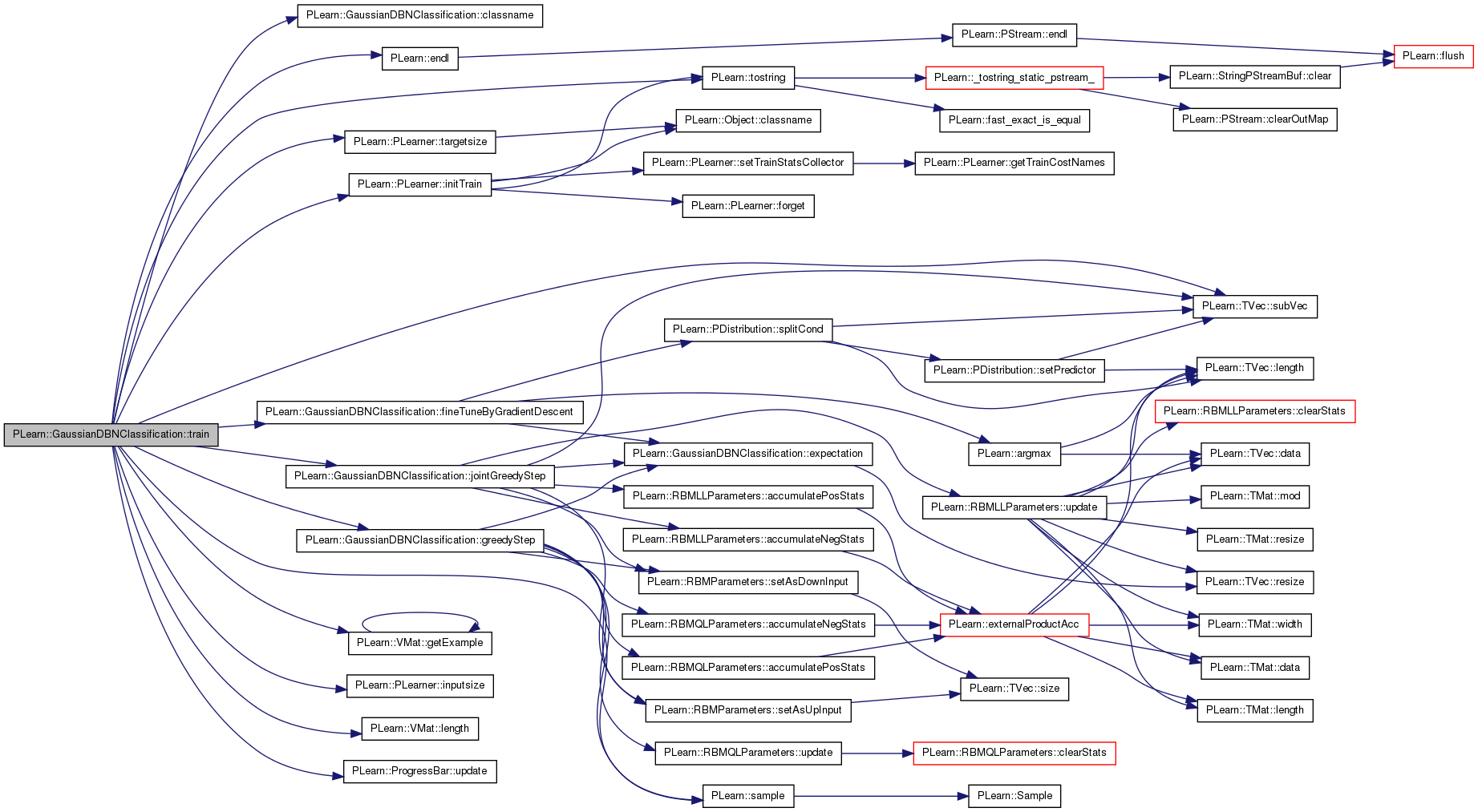
| void PLearn::GaussianDBNClassification::variance | ( | Mat & | cov | ) | const [virtual] |
Reimplemented from PLearn::PDistribution.
Definition at line 429 of file GaussianDBNClassification.cc.
References PLERROR.
{
PLERROR("variance not implemented for GaussianDBNClassification");
}
Reimplemented from PLearn::PDistribution.
Definition at line 245 of file GaussianDBNClassification.h.
TVec< Vec > PLearn::GaussianDBNClassification::activation_gradients [mutable, protected] |
gradients of cost wrt the activations (output of params)
Definition at line 261 of file GaussianDBNClassification.h.
Referenced by build_params(), and fineTuneByGradientDescent().
TVec< Vec > PLearn::GaussianDBNClassification::expectation_gradients [mutable, protected] |
gradients of cost wrt the expectations (output of layers)
Definition at line 264 of file GaussianDBNClassification.h.
Referenced by build_params(), and fineTuneByGradientDescent().
Method for fine-tuning the whole network after greedy learning.
One of:
Definition at line 130 of file GaussianDBNClassification.h.
Referenced by build_(), declareOptions(), and train().
The method used to initialize the weights:
Definition at line 88 of file GaussianDBNClassification.h.
Referenced by build_(), build_params(), and declareOptions().
Definition at line 111 of file GaussianDBNClassification.h.
Referenced by build_params(), declareOptions(), expectation(), forget(), greedyStep(), jointGreedyStep(), and makeDeepCopyFromShallowCopy().
Concatenation of target_layer and layers[n_layers-2].
Definition at line 105 of file GaussianDBNClassification.h.
Referenced by build_layers(), declareOptions(), jointGreedyStep(), and makeDeepCopyFromShallowCopy().
Parameters linking joint_layer and last_layer.
Contains params[n_layers-2] and target_params.
Definition at line 118 of file GaussianDBNClassification.h.
Referenced by build_params(), declareOptions(), expectation(), fineTuneByGradientDescent(), jointGreedyStep(), and makeDeepCopyFromShallowCopy().
Last layer, learning joint representations of input and target.
Definition at line 99 of file GaussianDBNClassification.h.
Referenced by build_layers(), build_params(), declareOptions(), jointGreedyStep(), and makeDeepCopyFromShallowCopy().
Layers that learn representations of the input, layers[0] is input layer, layers[n_layers-1] is last layer.
Definition at line 96 of file GaussianDBNClassification.h.
Referenced by build_(), build_layers(), build_params(), declareOptions(), expectation(), fineTuneByGradientDescent(), forget(), greedyStep(), jointGreedyStep(), makeDeepCopyFromShallowCopy(), and setPredictorPredictedSizes().
### declare public option fields (such as build options) here Start your comments with Doxygen-compatible comments such as //!
The learning rate
Definition at line 78 of file GaussianDBNClassification.h.
Referenced by build_params(), and declareOptions().
Number of layers, including input layer and last layer, but not target layer.
Definition at line 92 of file GaussianDBNClassification.h.
Referenced by build_(), build_layers(), build_params(), declareOptions(), expectation(), fineTuneByGradientDescent(), forget(), jointGreedyStep(), and train().
Vec PLearn::GaussianDBNClassification::output_gradient [mutable, protected] |
gradient wrt output activations
Definition at line 267 of file GaussianDBNClassification.h.
Referenced by build_params(), and fineTuneByGradientDescent().
RBMParameters linking the unsupervised layers.
params[i] links layers[i] and layers[i+1], i>0
Definition at line 109 of file GaussianDBNClassification.h.
Referenced by build_params(), declareOptions(), expectation(), fineTuneByGradientDescent(), forget(), greedyStep(), jointGreedyStep(), and makeDeepCopyFromShallowCopy().
Target (or label) layer.
Definition at line 102 of file GaussianDBNClassification.h.
Referenced by build_layers(), build_params(), declareOptions(), expectation(), fineTuneByGradientDescent(), forget(), jointGreedyStep(), makeDeepCopyFromShallowCopy(), and setPredictorPredictedSizes().
Parameters linking target_layer and last_layer.
Definition at line 114 of file GaussianDBNClassification.h.
Referenced by build_params(), declareOptions(), forget(), and makeDeepCopyFromShallowCopy().
Number of examples to use during each of the different greedy steps of the training phase.
Definition at line 122 of file GaussianDBNClassification.h.
Referenced by build_(), declareOptions(), makeDeepCopyFromShallowCopy(), and train().
| bool PLearn::GaussianDBNClassification::use_sample_rather_than_expectation_in_positive_phase_statistics |
Definition at line 132 of file GaussianDBNClassification.h.
Referenced by declareOptions(), greedyStep(), and jointGreedyStep().
The weight decay.
Definition at line 81 of file GaussianDBNClassification.h.
Referenced by declareOptions().
 1.7.4
1.7.4